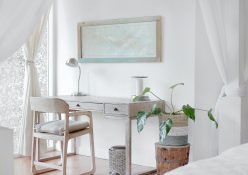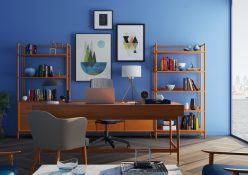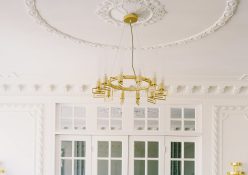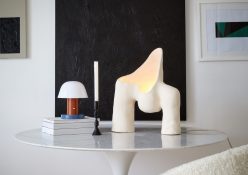A moody palette and playful design pieces intended for a nocturnal lifestyle make up the high-end but edgy spaces of Tristan du Plessis’ Joburg home
In an industry that is built on flamboyant personalities and high drama, designer Tristan du Plessis gets on with it quietly and without a whole lot of fuss. Surprisingly understated, he allows the spaces he creates to speak for themselves. But then he’s not really one for sticking to the rules anyway. Any meteoric rise in design goes largely against the norm in South Africa –in an industry often slightly restricted by relative isolation from international design hubs, growth is usually more gradual, but Tristan’s interior architecture company Studio A has all but dominated the interior scene of late. A kind of low-key local Peter Marino, he’s carved out a serious niche in the edgy but luxe urban space – spanning hospitality, hotels and homes – as well as a name for himself for his own personal style.

‘I feel that every project type has something to offer me in terms of my design growth. That said, I’m really enjoying the hotel projects I’m working on currently because they offer so many layers to unravel,’ he explains, an ideal challenge for someone who steers clear of minimalism. More is definitely more – when conceiving spaces, combining styles or choosing clothes. And while each project is of course tailored to its purpose, they’re always big on detail. ‘You could say I border on a maximalist approach – my intention is to create immersive experiences,’ he adds. His own home is a good microcosm of his design style as a whole, its gritty location belying a very luxe interior.

A four-level apartment, it sits on the edge of one of the most sought-after suburbs in Joburg (Westcliff), the food- and culture hotspot of Melville, and the hub of youth culture that is Braamfontein. ‘I’ve always liked this part of town because of its diversity, and being on the borders you get the best of all worlds,’ he comments. Drawn to juxtaposition in design too, his influences range from the quiet sophistication and attention to textural detail of Joseph Dirand and Tristan Auer, and the boldness of Masamichi Katayama, to the romance of Marcel Wanders or the sheer conceptual genius of Philippe Starck. All have dabbled in hospitality and retail as well as residential and created strong aesthetic identities, so it’s easy to see why Tristan feels an affinity with them.

In a similar fashion, he chose the elements of his space individually and on merit – each piece because it appealed, rather than to fit a predetermined scheme. ‘It’s less of a designed space and more of a collection of things I love or have enjoyed making. My love for design is the driving force behind my interior,’ he elaborates. And to draw a distinction – he means design, with a capital D, in the form of standalone pieces by iconic designers such as Le Corbusier, Tom Dixon and Serge Mouille. These lend gravitas to what is, at its heart, a space with a youthful attitude. ‘I sometimes feel like I’m living in someone else’s house … almost as if I’m pretending to be an adult,’ he adds.

He renovated the multilevel loft apartment from closed-off rooms into one extended space connected by industrial-style metal staircases – kitchen and dining at the bottom, bedroom and lounge one floor up, study next and then the roof terrace and outdoor bar area at the top. ‘The idea of every home function having a designated room is a completely antiquated concept. Instead I designed the spaces to make them liveable for me,’ Tristan explains. Part of that liveability includes a sense of space and feeling of luxury.
 Subscribe to Livingspace, to recieve monthly updates on all decor trends.
Subscribe to Livingspace, to recieve monthly updates on all decor trends.





